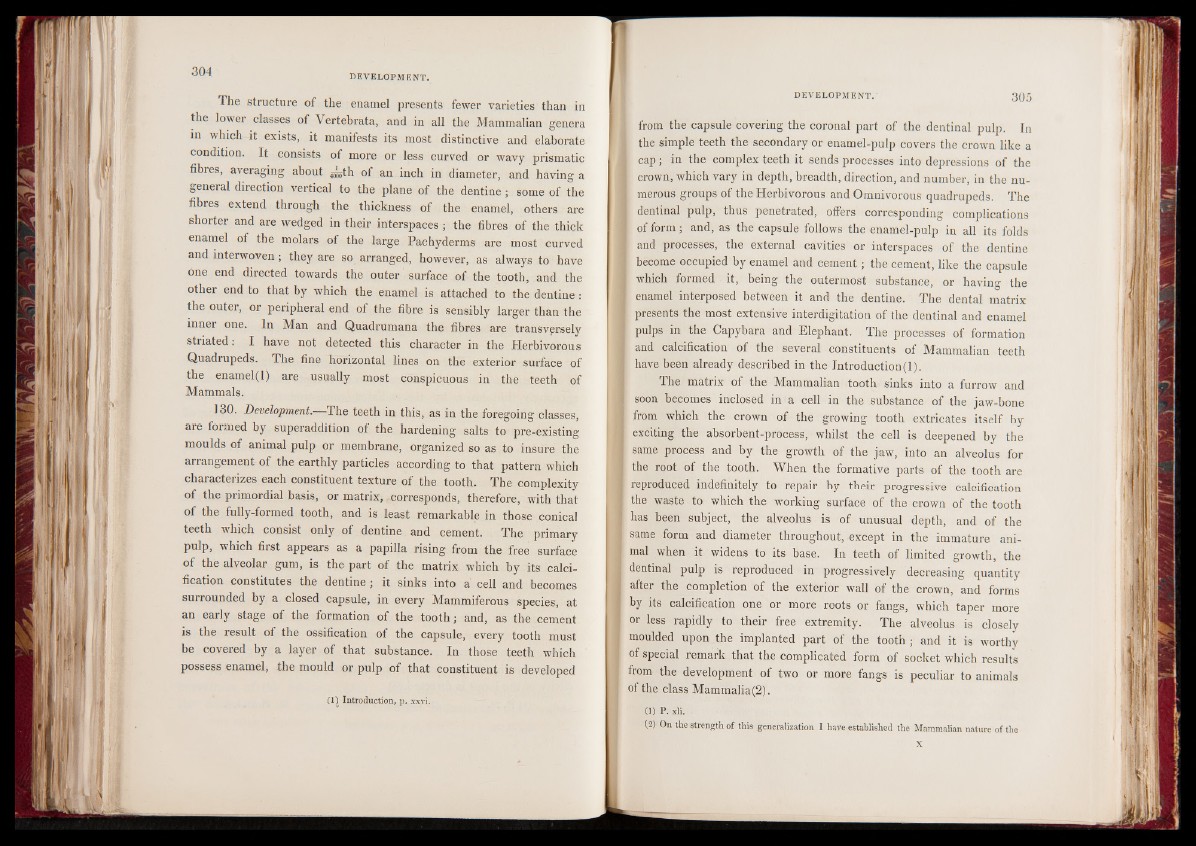
The structure of the enamel presents fewer varieties than in
the lower classes of Vertebrata, and in all the Mammalian genera
in which it exists, it manifests its most distinctive and elaborate
condition. It consists of more or less curved or wavy prismatic
fibres, averaging about ^ th of an inch in diameter, and having a
general direction vertical to the plane of the dentine ; some of the
fibres extend through the thickness of the enamel, others are
shorter and are wedged in their interspaces ; the fibres of the thick
enamel of the molars of the large Pachyderms are most curved
and interwoven; they are so arranged, however, as always to have
one end directed towards the outer surface of the tooth, and the
other end to that by which the enamel is attached to the dentine :
the outer, or peripheral end of the fibre is sensibly larger than the
inner one. In Man and Quadrumana the fibres are transversely
striated: I have not detected this character in the Herbivorous
Quadrupeds. The fine horizontal lines on the exterior surface of
the enamel(l) are usually most conspicuous in the teeth of
Mammals.
130. Development. The teeth in this, as in the foregoing classes,
are formed by superaddition of the hardening salts to pre-existing
moulds of animal pulp or membrane, organized so as to insure the
arrangement of the earthly particles according to that pattern which
characterizes each constituent texture of the tooth. The complexity
of the primordial basis, or matrix, corresponds, therefore, with that
of the fully-formed tooth, and is least remarkable in those conical
teeth which consist only of dentine and cement. The primary
pulp, which first appears as a papilla rising from the free surface
of the alveolar gum, is the part of the matrix which by its calcification
constitutes the dentine ; it sinks into a cell and becomes
surrounded by a closed capsule, in every Mammiferous species, at
an early stage of the formation of the tooth; and, as the cement
is the result of the ossification of the capsule, every tooth must
be covered by a layer of that substance. In those teeth which
possess enamel, the mould or pulp of that constituent is developed
fl) Introduction, j>. xxvi.
> from the capsule covering the coronal part of the dentinal pulp. In
the simple teeth the secondary or enamel-pulp covers the crown like a
I cap ; in the complex teeth it sends processes into depressions of the
I crown, which vary in depth, breadth, direction, and number, in the nu-
[ merous groups of the Herbivorous and Omnivorous quadrupeds. The
[ dentinal pulp, thus penetrated, offers corresponding complications
I of form ; and, as the capsule follows the enamel-pulp in all its folds
and processes, the external cavities or interspaces of the dentine
become occupied by enamel and cement ; the cement, like the capsule
which formed it, being the outermost substance, or having the
enamel interposed between it and the dentine. The dental matrix
I presents the most extensive interdigitation of the dentinal and enamel
pulps in the Capybara and Elephant. The processes of formation
; and calcification of the several constituents of Mammalian teeth
have been already described in the Introduction(l).
The matrix of the Mammalian tooth sinks into a furrow and
\ soon becomes inclosed in a cell in the substance of the jaw-bone
from which the crown of the growing tooth extricates itself by
exciting the absorbent-process, whilst the cell is deepened by the
same process and by the growth of the jaw, into an alveolus for
the root of the tooth. When the formative parts of the tooth are
reproduced indefinitely to repair by their progressive calcification
the waste to which the working surface of the crown of the tooth
has been subject, the alveolus is of unusual depth, and of the
same form and diameter throughout, except in the immature animal
when it widens to its base. In teeth of limited growth, the
dentinal pulp is reproduced in progressively decreasing quantity
after the completion of the exterior wall of the crown, and forms
by its calcification one or more roots or fangs, which taper more
or less rapidly to their free extremity. The alveolus is closely
moulded upon the implanted part of the tooth; and it is worthy
of special remark that the complicated form of socket which results
from the development of two or more fangs is peculiar to animals
of the class Mammalia(2).
(1) P. xli.
(2) On the strength of this generalization I have established the Mammalian nature of the